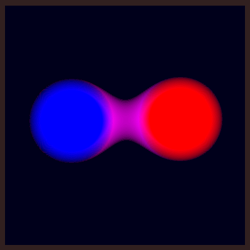About me:
Hi, my name is Christian and I am an enthusiast for games and simulations in the field of artificial life. I am an applied mathematician and have worked in my past for several years as a researcher on mathematical problems for damage mechanics. Currently I am employed as a software engineer.
Physics engine:
What I want to announce here is a 2D physics engine for damageable and glueable rigid bodys. Temperature effects such as radiation and heat conduction are also simulated via certain particles and internal energy distributions. The building blocks (nodes) of the bodys can be programmed by a simple assembler-like language enriched with physical actions, communication, sensoring and procreation functions. Portions of code is stored in each node as machine code and also potentially subject to changes. The code is processed by tokens moving/forking on a directed graph which constitutes the body. To get an impression of how the engine looks like in practice I attach some screencasts showing different examples. The engine performs multithreaded computations and is encapsulated in a C++-framework. I think it could be used to create realistic effects for space games. I am very interested in your ideas, opinions and constructive criticism.
https://www.youtube.com/watch?v=DG61uprKzWg
https://www.youtube.com/watch?v=2L3Cr2WwHDc
Performance:
With the current implementation one could simulate rougly 50k - 100k building blocks with 30 fps using 8 CPU threads (measured on Core i7-6700). There is still no finished GPU implementation but after experimenting with CUDA I would estimate that 300k can be simulated
on my GPU (GeForce 960 GTX). To get an idea of of the computational effort please think that every building block in the scene (size of a pixel in the video) can be glued or detached to/from a body and performs calculations or other physical actions. The high degree of dynamics in simulation (damage and coalescence, function of nodes can change) was one the biggest challenge in the development.
For broader applications it would be quite nice to port this engine to Unity. But I fear that the performance would then decrease substantially.
Editor:
In order to demostrate the engine I had developed an editor/simulator named alien. It allows to create and modify simulations filled with bodys. alien provides a pixel view as well as a graph and code editor for designing and visualizing every detail in a scene. As an demonstrating example I have designed a replicating machines that consumes nearby materials (see video below). More complex machines with sensoring, communication and attacking skills are also conceivable. Thus the material in the simulated world could be equipped with life-like or even intelligent behavior.
https://www.youtube.com/watch?v=Slba3g7-LK4
More information and download:
alien-project.org (it's opensource)




